Shader "Custom/Hardlight" {
Properties { // Unity uses these to generate UI to customize the shader with
_Color ("Color", Color) = (1,1,1,1)
_HexTex ("Hex Texture", 2D) = "white" {}
_DisplaceSpeedX ("X Hex Displacement Speed", Range(0,10)) = 0.0
_DisplaceSpeedY ("Y Hex Displacement Speed", Range(0,10)) = 0.0
_SecDisplaceX ("Secondary X Displacement", Range(0,1)) = 1.0
_SecDisplaceY ("Secondary Y Displacement", Range(0,1)) = 1.0
_SecondaryMultiplier ("Secondary Hex Multiplier", Range(0,1)) = 1.0
_BorderSize ("Border Glow Size", Range(0, 10)) = 8.0
_BorderColor ("Border Glow Color", Color) = (1,1,1,1)
}
SubShader {
// Transparent tags so the sphere in back can render through
Tags { "RenderType"="Transparent" "Queue"="Transparent" "IgnoreProjector"="True" }
LOD 200
CGPROGRAM
// Physically based Standard lighting model, and enable shadows on all light types
#pragma surface surf Standard fullforwardshadows alpha:fade
// Use shader model 3.0 target, to get nicer looking lighting
#pragma target 3.0
sampler2D _HexTex;
struct Input {
float2 uv_HexTex;
};
// Import variable from Unity custom material
fixed4 _Color;
fixed4 _BorderColor;
fixed _DisplaceSpeedX;
fixed _DisplaceSpeedY;
fixed _SecDisplaceX;
fixed _SecDisplaceY;
fixed _SecondaryMultiplier;
fixed _BorderSize;
void surf (Input IN, inout SurfaceOutputStandard o) {
const float PI = 3.14159;
// First displacement of UV coordinated for scrolling UVs
fixed scrollX = _Time * _DisplaceSpeedX + IN.uv_HexTex.x;
fixed scrollY = _Time * _DisplaceSpeedY + IN.uv_HexTex.y;
float2 newUV = float2(scrollX, scrollY);
// Separate hex into channels
float4 hex = tex2D(_HexTex, newUV);
float r = hex.r;
float g = hex.g;
float b = hex.b;
// Apply wavey distortion from the red channel to the UV coordinates
float2 displaceUV = float2(r,r) * 0.1 + IN.uv_HexTex;
// Store the primary grid result into a color
fixed4 firstHex = tex2D(_HexTex, displaceUV).b * _Color;
firstHex.a = r;
// Calculate border fade from cosine of the UV coordinates
// Simply put, it gets a 1 for the edges of the UV space and a 0 for the middle
// NOTE: this will only work on objects that span the entire UV space, the proper way
// to fix this would be to add the border based on either another texture or angle of the camera on the object
float xBorder = pow(cos(PI*displaceUV.x), _BorderSize);
float yBorder = pow(cos(PI*displaceUV.y), _BorderSize);
// Second grid displacement
float dx = _SecDisplaceX + _SinTime * 0.1;
float dy = _SecDisplaceY + _SinTime * 0.1;
displaceUV += float2(dx, dy);
// Second grid fragment
fixed4 secondHex = tex2D(_HexTex, displaceUV).b * _Color * _SecondaryMultiplier;
fixed4 c = firstHex + secondHex + r * _Color * 1.5;
fixed4 border = _BorderColor;
border *= (xBorder + yBorder);
c += border;
// Give resulting combination to the standard Unity lighting function
o.Albedo = c.rgb;
o.Alpha = c.a;
}
ENDCG
}
FallBack "Diffuse"
}



